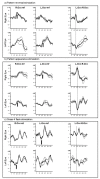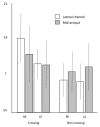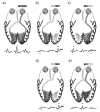Occipital Petalia and Albinism: A Study of Interhemispheric VEP Asymmetries in Albinism with No Nystagmus
- PMID: 31195712
- PMCID: PMC6617331
- DOI: 10.3390/jcm8060802
Occipital Petalia and Albinism: A Study of Interhemispheric VEP Asymmetries in Albinism with No Nystagmus
Abstract
The purpose of this study was to assess chiasmal misrouting in a cohort of children with albinism with no nystagmus using hemifield visual evoked potentials (VEP) measures.
Methods: Monocular VEPs were recorded and analyzed from three electrodes (O1, Oz, and O2 referred to Fz) from 16 children with albinism without nystagmus. Pattern reversal (full field and hemifield stimulation), full field pattern appearance and flash stimuli were used to evoke VEPs for each eye.
Results: The amplitude of the pattern reversal VEPs to stimulation of the hemifield corresponding to the crossing pathways were as expected significantly larger than those to the non-crossing in each eye ((right eye p = 0.000004), (left eye p = 0.001)). Pattern reversal VEPs recorded from the left hemisphere were also larger than those from the right and most evident when comparing the crossing pathways of each eye (p = 0.004).
Conclusions: This study has demonstrated electrophysiological differences in visual pathway function of the left and right hemisphere in subjects with albinism like that previously described in controls. Nasal field stimulation activated crossing and non-crossing pathways in patients with albinism and as a result, nasal hemifield VEPs in albinism are less lateralized compared to what is found in normal subjects.
Keywords: albinism; hemifield; misrouting; visual evoked potential.
Conflict of interest statement
The authors declare no conflict of interest.
Figures





References
LinkOut - more resources
Full Text Sources

